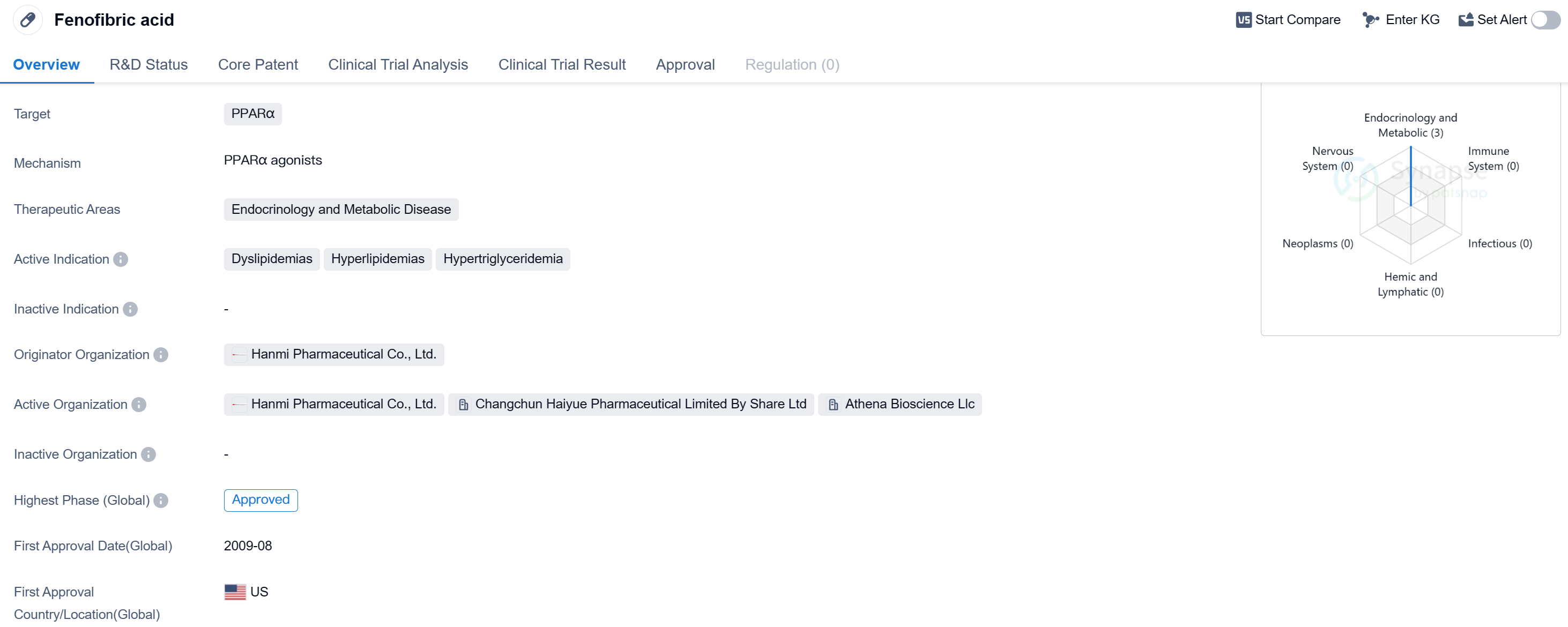Fenofibric acid Unveiled: A Detailed Overview of its Revolutionary R&D Breakthroughs, Mechanisms of Action, and Drug Target
Fenofibric acid's R&D Progress
Fenofibric acid is a small molecule drug that falls under the therapeutic area of endocrinology and metabolic disease. It specifically targets PPARα, a receptor involved in lipid metabolism. The drug is primarily indicated for the treatment of dyslipidemias, hyperlipidemias, and hypertriglyceridemia.
The originator organization of Fenofibric acid is Hanmi Pharmaceutical Co., Ltd., a pharmaceutical company based in South Korea. The drug has achieved the highest phase of approval globally.
Fenofibric acid received its first approval in the United States in August 2009, making it available for use in the American market. The drug's approval in the United States suggests that it has undergone rigorous clinical trials and demonstrated its safety and efficacy to regulatory authorities.
As a small molecule drug, Fenofibric acid is likely to have a well-defined chemical structure, allowing for easy synthesis and formulation. This characteristic may contribute to its successful development and approval.
The therapeutic areas of endocrinology and metabolic disease encompass a wide range of conditions related to hormone imbalances and metabolic disorders. Dyslipidemias, hyperlipidemias, and hypertriglyceridemia are conditions characterized by abnormal lipid levels in the blood, which can increase the risk of cardiovascular diseases.
Fenofibric acid's specific targeting of PPARα suggests that it may work by modulating lipid metabolism and reducing lipid levels in the blood. By doing so, it may help manage dyslipidemias, hyperlipidemias, and hypertriglyceridemia, potentially reducing the risk of associated cardiovascular complications.
👇Please click on the image below to directly access the latest data (R&D Status | Core Patent | Clinical Trial | Approval status in Global countries) of this drug.
Mechanism of Action for Fenofibric acid: PPARα agonists
PPARα agonists are a type of medication that activate the peroxisome proliferator-activated receptor alpha (PPARα) in the body. PPARα is a nuclear receptor that plays a crucial role in regulating lipid metabolism, particularly in the liver. When activated by PPARα agonists, this receptor increases the expression of genes involved in fatty acid oxidation, leading to enhanced breakdown of fatty acids and increased energy production.
From a biomedical perspective, PPARα agonists are used in the treatment of dyslipidemia, a condition characterized by abnormal levels of lipids (such as cholesterol and triglycerides) in the blood. By activating PPARα, these medications help to lower lipid levels by promoting the breakdown and clearance of fatty acids. This can lead to improved lipid profiles and reduced risk of cardiovascular diseases, such as atherosclerosis and heart disease.
Some examples of PPARα agonists include fenofibrate and gemfibrozil, which are commonly prescribed to patients with high cholesterol or triglyceride levels. These medications are typically taken orally and work by binding to PPARα receptors in the liver and other tissues, stimulating the expression of genes involved in lipid metabolism. However, it is important to note that PPARα agonists may have side effects, such as liver toxicity and muscle-related complications, which should be monitored by healthcare professionals during treatment.
Drug Target R&D Trends for Fenofibric acid
According to Patsnap Synapse, as of 14 Sep 2023, there are a total of 127 PPARα drugs worldwide, from 154 organizations, covering 110 indications, and conducting 917 clinical trials.
The analysis of the target PPARα reveals a competitive landscape with multiple companies growing rapidly under this target. The highest stage of development is the approved phase, indicating successful drug development for relevant indications. Small molecule drugs are progressing most rapidly, indicating a focus on this drug type. China is developing fastest under the target PPARα, followed by the European Union, United States, and Japan. The specific progress in China needs further analysis to understand its impact on the competitive landscape. Overall, the target PPARα shows promising potential for future development in the pharmaceutical industry.
👇Please click on the picture link below for free registration or log in directly if you have a freemium account, you can browse the latest research progress on drugs, indications, organizations, clinical trials, clinical results, and drug patents related to this target
Conclusion
In summary, Fenofibric acid is a small molecule drug developed by Hanmi Pharmaceutical Co., Ltd. It targets PPARα and is indicated for the treatment of dyslipidemias, hyperlipidemias, and hypertriglyceridemia. The drug has achieved the highest phase of approval globally, with its first approval obtained in the United States in 2009. Fenofibric acid's approval and therapeutic focus on endocrinology and metabolic disease highlight its potential in managing lipid-related disorders and reducing the risk of cardiovascular complications.






